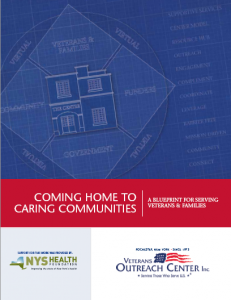 The decade of continuous combat in Iraq and Afghanistan has created a demand for veterans’ services that the US has not experienced since Vietnam. The sheer numbers of veterans (almost 2 million troops deployed since 2001) would be hard enough for the Veterans Administration (VA) to address. But the heavy reliance on National Guard and Reservists has changed the veteran population, subsequent needs and community impact substantially.
The decade of continuous combat in Iraq and Afghanistan has created a demand for veterans’ services that the US has not experienced since Vietnam. The sheer numbers of veterans (almost 2 million troops deployed since 2001) would be hard enough for the Veterans Administration (VA) to address. But the heavy reliance on National Guard and Reservists has changed the veteran population, subsequent needs and community impact substantially.
 Last week’s release of a NYS Health Foundation– funded report by Rochester’s Veterans Outreach Center sheds light on the complex needs of returning vets—Coming Home to Caring Communities, A Blueprint for Serving Veterans and Families. Full disclosure, CGR had the privilege of helping to author the blueprint.
Last week’s release of a NYS Health Foundation– funded report by Rochester’s Veterans Outreach Center sheds light on the complex needs of returning vets—Coming Home to Caring Communities, A Blueprint for Serving Veterans and Families. Full disclosure, CGR had the privilege of helping to author the blueprint.
The report reminds us that there’s a moral imperative to improve service delivery for a deserving and vulnerable population. Our country hasn’t yet found the perfect way to embrace our veterans as they return to civilian life. The Blueprint is an experiment in replicating and “scaling” effective practices across a state, an approach that highlights an emerging shift in the federal approach to veterans’ services.
The Need
Over 6,200 families have lost their soldier, more than 46,000 soldiers have returned physically injured, and thousands more await diagnosis of “invisible wounds” such as post-traumatic stress disorder (PTSD). The toll of combat is not unique to this generation of veterans, nor do they exceed the number of Vietnam veterans. The change in veteran population, however, is significant enough that it requires a different approach to providing services.
Returning veterans from Operation Enduring Freedom (Afghanistan) and Operation Iraqi Freedom (Iraq) tend to be older, include more women, and be more geographically dispersed. Families and communities are uniquely affected because of the heavy reliance on members of the National Guard and the Reserves, individuals who are settled members of communities across America. These soldiers were called away from their families and civilian jobs, often for multiple deployments. The central military base providing built-in support for families during deployment or reintegration is no longer the norm.
Not Just the VA’s Business Anymore
For these reasons, reintegration is a local community issue, not just a matter for the Veterans Administration. Changing needs demand corresponding changes in service delivery, outreach and points of access. One example: NYSHealth’s 2011 needs assessment of NYS veterans (conducted by RAND) reports a large majority of veterans and spouses prefer to access health care from the community rather than from VA providers. Many have other, non-VA health insurance. This is borne out by VA data showing that it doesn’t reach the preponderance of eligible veterans. This suggests that education for non-military health providers in areas such as PTSD and military benefits should be more of a priority. It’s also essential to do a better job of identifying veterans returning to local communities. Moreover, the needs themselves have expanded to require more emphasis on family supports, employer training, and education for community providers such as schools and healthcare sites.
Research at the state and national levels calls for the Department of Defense and the VA to partner more closely with communities. The VA, under General Eric Shinseki’s direction, has recognized that it cannot serve veterans alone. Recent funding decisions, such as the Supportive Services for Veterans Families grants, have been aligned around this community-based, public-private partnership concept.
The Blueprint
There are countless well-intentioned individuals, coalitions and organizations who want to “support vets.” What is rarer is a documented approach for doing so in a way that ensures quality care and sustainability. This blueprint uses a case study of the Veterans Outreach Center, the nation’s oldest nonprofit serving veterans, to articulate and describe the core elements of a community center-based approach. The Blueprint offers a detailed roadmap to plan, implement and fund such a model, which should allow other communities to adopt the approach modeled by the VOC, to more effectively support those who have served in the military.
Over the last four years, CGR has been proud to work (often supporting the VOC) with nine NY counties to better understand what a more coordinated network of services for veterans and their families would look like, and we know that communities across the state are engaged in similar efforts. Our hope is that rather than starting from scratch, they find the Blueprint a useful tool in building more “Caring Communities.”
We are all responsible for ensuring that returning vets get the support they need. The Blueprint will be most helpful for service providers directly engaged with veterans or those who have a personal stake in improving the quality of life for veterans. But all of us have a role to play in recognizing that veterans and their families are a growing and embedded part of our community well-being, even if you don’t live near an active base.